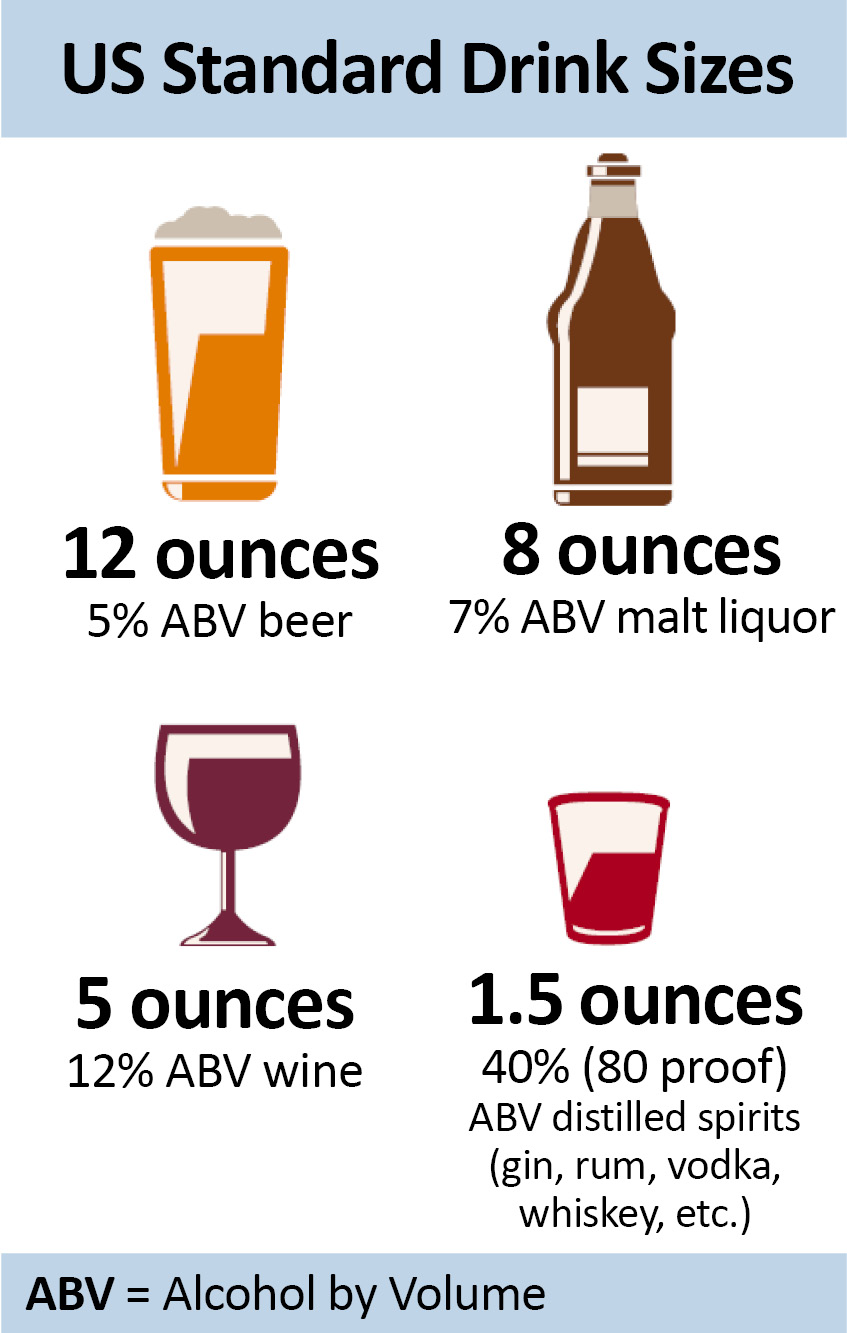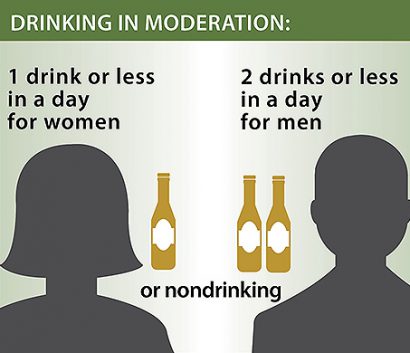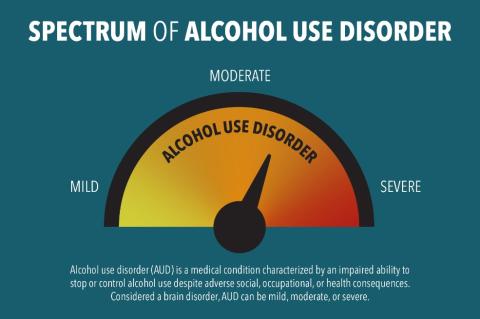For most adults, moderate alcohol use is probably not harmful. However, about 18 million adult Americans have an alcohol use disorder. This means that their drinking causes distress and harm. It includes alcoholism and alcohol abuse.
Alcoholism, or alcohol dependence, is a disease that causes
- Craving – a strong need to drink
- Loss of control – not being able to stop drinking once you’ve started
- Physical dependence – withdrawal symptoms
- Tolerance – the need to drink more alcohol to feel the same effect
With alcohol abuse, you are not physically dependent, but you still have a serious problem. The drinking may cause problems at home, work, or school. It may cause you to put yourself in dangerous situations, or lead to legal or social problems.
Another common problem is binge drinking. It is drinking about five or more drinks in two hours for men. For women, it is about four or more drinks in two hours.
Too much alcohol is dangerous. Heavy drinking can increase the risk of certain cancers. It can cause damage to the liver, brain, and other organs. Drinking during pregnancy can harm your baby. Alcohol also increases the risk of death from car crashes, injuries, homicide, and suicide.
If you want to stop drinking, there is help. Start by talking to your health care provider. Treatment may include medicines, counseling, and support groups.
What is a standard drink?

In the United States, a standard drink contains 0.6 ounces (14.0 grams or 1.2 tablespoons) of pure alcohol. Generally, this amount of pure alcohol is found in
- 12-ounces of beer (5% alcohol content).
- 8-ounces of malt liquor (7% alcohol content).
- 5-ounces of wine (12% alcohol content).
- 1.5-ounces of 80-proof (40% alcohol content) distilled spirits or liquor (e.g., gin, rum, vodka, whiskey).4
What is excessive drinking?
Excessive drinking includes binge drinking, heavy drinking, and any drinking by pregnant women or people younger than age 21.
- Binge drinking, the most common form of excessive drinking, is defined as consuming
- For women, 4 or more drinks during a single occasion.
- For men, 5 or more drinks during a single occasion.
- Heavy drinking is defined as consuming
- For women, 8 or more drinks per week.
- For men, 15 or more drinks per week.
Most people who drink excessively are not alcoholics or alcohol dependent.5
What is moderate drinking?

The Dietary Guidelines for Americans recommends that adults of legal drinking age can choose not to drink, or to drink in moderation by limiting intake to 2 drinks or less in a day for men or 1 drink or less in a day for women, on days when alcohol is consumed.
The Guidelines also do not recommend that individuals who do not drink alcohol start drinking for any reason and that if adults of legal drinking age choose to drink alcoholic beverages, drinking less is better for health than drinking more.
There are some people who should not drink any alcohol, including those who are:
- Younger than age 21.
- Pregnant or may be pregnant.
- Driving, planning to drive, or participating in other activities requiring skill, coordination, and alertness.
- Taking certain prescription or over-the-counter medications that can interact with alcohol.
- Suffering from certain medical conditions.
- Recovering from alcoholism or are unable to control the amount they drink.
By adhering to the Dietary Guidelines, you can reduce the risk of harm to yourself or others.
Short-Term Health Risks
Excessive alcohol use has immediate effects that increase the risk of many harmful health conditions. These are most often the result of binge drinking and include the following:
- Injuries, such as motor vehicle crashes, falls, drownings, and burns.
- Violence, including homicide, suicide, sexual assault, and intimate partner violence.
- Alcohol poisoning, a medical emergency that results from high blood alcohol levels.
- Risky sexual behaviors, including unprotected sex or sex with multiple partners. These behaviors can result in unintended pregnancy or sexually transmitted diseases, including HIV.
- Miscarriage and stillbirth or fetal alcohol spectrum disorders (FASDs) among pregnant women.
Long-Term Health Risks
Over time, excessive alcohol use can lead to the development of chronic diseases and other serious problems including:
- High blood pressure, heart disease, stroke, liver disease, and digestive problems.
- Cancer of the breast, mouth, throat, esophagus, voice box, liver, colon, and rectum.
- Weakening of the immune system, increasing the chances of getting sick.
- Learning and memory problems, including dementia and poor school performance.
- Mental health problems, including depression and anxiety.
- Social problems, including family problems, job-related problems, and unemployment.
- Alcohol use disorders, or alcohol dependence.
By not drinking too much, you can reduce the risk of these short- and long-term health risks.
Understanding Alcohol Use Disorder

Alcohol use disorder (AUD) is a medical condition characterized by an impaired ability to stop or control alcohol use despite adverse social, occupational, or health consequences. It encompasses the conditions that some people refer to as alcohol abuse, alcohol dependence, alcohol addiction, and the colloquial term, alcoholism. Considered a brain disorder, AUD can be mild, moderate, or severe. Lasting changes in the brain caused by alcohol misuse perpetuate AUD and make individuals vulnerable to relapse. The good news is that no matter how severe the problem may seem, evidence-based treatment with behavioral therapies, mutual-support groups, and/or medications can help people with AUD achieve and maintain recovery. According to the 2021 National Survey on Drug Use and Health, 28.6 million adults ages 18 and older (11.3% in this age group) had AUD in 2021.1,2 Among youth, an estimated 894,000 adolescents ages 12 to 17 (3.4% of this age group) had AUD during this time frame.
What Increases the Risk for Alcohol Use Disorder?
A person’s risk for developing AUD depends in part on how much, how often, and how quickly they consume alcohol. Alcohol misuse, which includes binge drinking and heavy alcohol use, over time increases the risk of AUD. Other factors also increase the risk of AUD, such as:
- Drinking at an early age. A recent national survey found that among people ages 26 and older, those who began drinking before age 15 were more than three times as likely to report having AUD in the past year as those who waited until age 21 or later to begin drinking.3 The risk for females in this group is higher than that of males.
- Genetics and family history of alcohol problems. Genetics play a role, with hereditability accounting for approximately 60%; however, like other chronic health conditions, AUD risk is influenced by the interplay between a person’s genes and their environment. Parents’ drinking patterns may also influence the likelihood that a child will one day develop AUD.
- Mental health conditions and a history of trauma. A wide range of psychiatric conditions—including depression, post-traumatic stress disorder, and attention deficit hyperactivity disorder—are comorbid with AUD and are associated with an increased risk of AUD. People with a history of childhood trauma are also vulnerable to AUD.
What Are the Symptoms of Alcohol Use Disorder?
Health care professionals use criteria from the Diagnostic and Statistical Manual of Mental Disorders, Fifth Edition (DSM-5), to assess whether a person has AUD and to determine the severity, if the disorder is present. Severity is based on the number of criteria a person meets based on their symptoms—mild (2–3 criteria), moderate (4–5 criteria), or severe (6 or more criteria).
A health care provider might ask the following questions to assess a person’s symptoms.
In the past year, have you:
- Had times when you ended up drinking more, or longer, than you intended?
- More than once wanted to cut down or stop drinking, or tried to, but couldn’t?
- Spent a lot of time drinking, being sick from drinking, or getting over other aftereffects?
- Wanted a drink so badly you couldn’t think of anything else?
- Found that drinking—or being sick from drinking—often interfered with taking care of your home or family? Or caused job troubles? Or school problems?
- Continued to drink even though it was causing trouble with your family or friends?
- Given up or cut back on activities you found important, interesting, or pleasurable so you could drink?
- More than once gotten into situations while or after drinking that increased your chances of getting hurt (such as driving, swimming, using machinery, walking in a dangerous area, or unsafe sexual behavior)?
- Continued to drink even though it was making you feel depressed or anxious or adding to another health problem? Or after having had an alcohol-related memory blackout?
- Had to drink much more than you once did to get the effect you want? Or found that your usual number of drinks had much less effect than before?
- Found that when the effects of alcohol were wearing off, you had withdrawal symptoms, such as trouble sleeping, shakiness, restlessness, nausea, sweating, a racing heart, dysphoria (feeling uneasy or unhappy), malaise (general sense of being unwell), feeling low, or a seizure? Or sensed things that were not there?
Any of these symptoms may be cause for concern. The more symptoms, the more urgent the need for change.
How to Treat Alcohol Dependence ?
Treating alcohol dependence (also known as alcohol use disorder or AUD) requires a comprehensive approach that combines medical treatment, counseling, lifestyle changes, and support systems. The process usually involves several steps, tailored to an individual’s specific needs, to help them reduce or stop their alcohol use safely and effectively.
1. Acknowledging the Problem
- Recognizing alcohol dependence: The first step in treatment is acknowledging the problem. Symptoms of alcohol dependence include the inability to control drinking, withdrawal symptoms when not drinking, and continuing to drink despite knowing the negative consequences.
- Seeking professional help: Many people find it helpful to consult a healthcare provider or addiction specialist to get a proper diagnosis and treatment plan.
2. Detoxification (Detox)
- Medical detox: For individuals with severe alcohol dependence, quitting drinking abruptly can lead to dangerous withdrawal symptoms, such as seizures, delirium tremens (DTs), or severe anxiety. Medical detox under supervision is often necessary to manage withdrawal symptoms safely.
- Medications for withdrawal: In a detox setting, medications like benzodiazepines (e.g., diazepam or lorazepam) may be used to prevent seizures, ease anxiety, and manage other symptoms.
3. Medications for Alcohol Dependence
Several medications are available to help reduce alcohol cravings, prevent relapse, or discourage drinking:
- Disulfiram (Antabuse): This medication causes unpleasant physical reactions (e.g., nausea, vomiting, headaches) when alcohol is consumed, deterring the person from drinking.
- Naltrexone: This medication blocks the euphoria and effects of alcohol, reducing the desire to drink and helping to prevent relapse.
- Acamprosate (Campral): Acamprosate helps reduce cravings and withdrawal symptoms by stabilizing brain activity in individuals who have already stopped drinking.
4. Behavioral Therapy and Counseling
Therapy plays a central role in treating alcohol dependence, helping individuals understand their addiction, cope with cravings, and change harmful behaviors.
- Cognitive-behavioral therapy (CBT): CBT helps individuals identify and change negative thought patterns and behaviors related to drinking. It teaches coping mechanisms for handling stress, triggers, and urges to drink.
- Motivational enhancement therapy (MET): MET helps individuals build motivation to change their drinking habits and commit to recovery.
- Contingency management: This approach involves providing tangible rewards for maintaining sobriety, reinforcing positive behaviors.
- Family and couples therapy: Involving loved ones in therapy can help address relationship issues and build a strong support system.
5. Support Groups and Peer Support
- 12-Step Programs (e.g., Alcoholics Anonymous, AA): AA offers peer support through a structured 12-step program, which focuses on admitting powerlessness over alcohol, seeking help from a higher power, and making amends for past behavior. AA meetings provide a sense of community and accountability.
- SMART Recovery: This non-12-step program uses scientifically based tools and techniques to help individuals manage their addiction. It focuses on self-reliance, motivation, and managing urges.
- Other support groups: Support groups like Al-Anon and Alateen offer support for friends and family members of those dealing with alcohol addiction.
6. Lifestyle Changes and Self-Management Strategies
- Avoiding triggers: Identify and avoid situations or people that may tempt you to drink, such as social settings where alcohol is present or stressful environments.
- Building healthy habits: Exercise, nutritious eating, and regular sleep patterns can improve mood and overall well-being, helping you manage stress without turning to alcohol.
- Stress management: Learn stress-reduction techniques such as mindfulness, meditation, and relaxation exercises to cope with anxiety and stress in healthier ways.
7. Inpatient or Outpatient Rehabilitation Programs
- Inpatient rehab: Residential treatment programs provide a structured, alcohol-free environment with 24-hour care. These programs typically last 30, 60, or 90 days and are ideal for individuals with severe alcohol dependence or those who have not succeeded with outpatient treatment.
- Outpatient rehab: Outpatient programs allow individuals to live at home while attending therapy sessions and group meetings. This option is ideal for those with milder forms of alcohol dependence or those who cannot commit to inpatient care due to work or family responsibilities.
8. Aftercare and Relapse Prevention
- Ongoing support: After initial treatment, long-term support is essential to prevent relapse. This can involve regular counseling, attending support group meetings, and continued medication use.
- Relapse prevention planning: Work with your therapist to develop strategies for managing cravings and dealing with high-risk situations that could lead to relapse.
9. Treatment for Co-Occurring Disorders
- Dual diagnosis: Many individuals with alcohol dependence also suffer from mental health conditions like depression, anxiety, or PTSD. Treating both the addiction and the underlying mental health disorder is crucial for recovery.
- Integrated treatment: Therapy for co-occurring disorders typically involves a combination of counseling, medications, and lifestyle changes to address both conditions simultaneously.
10. Family and Social Support
- Involvement of family and friends: Support from loved ones can significantly improve the success of treatment. Family members may participate in counseling to understand how to best support the individual.
- Strengthening relationships: Building strong social connections with people who support a sober lifestyle is key to long-term recovery.
11. Monitoring Progress
- Regular check-ins: Ongoing meetings with healthcare providers or counselors can help monitor progress, address setbacks, and adjust treatment plans as needed.
- Celebrate milestones: Acknowledge and celebrate milestones in recovery, such as weeks, months, or years of sobriety, to stay motivated.
Conclusion
Alcohol dependence treatment is a long-term process that requires commitment, support, and a personalized plan that may involve medications, therapy, support groups, and lifestyle changes. By seeking help, creating a strong support network, and staying dedicated to recovery, individuals can successfully manage alcohol dependence and improve their quality of life.